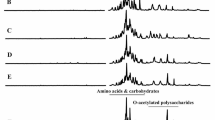Abstract
Three-layer artificial neural networks (ANN) capable of recognizing the type of raw material (herbs, leaves, flowers, fruits, roots or barks) using the non-metals (N, P, S, Cl, I, B) contents as inputs were designed. Two different types of feed-forward ANNs — multilayer perceptron (MLP) and radial basis function (RBF), best suited for solving classification problems, were used. Phosphorus, nitrogen, sulfur and boron were significant in recognition; chlorine and iodine did not contribute much to differentiation. A high recognition rate was observed for barks, fruits and herbs, while discrimination of herbs from leaves was less effective. MLP was more effective than RBF.
Similar content being viewed by others
References
H.B. Matthews, G.W. Lucier, K.D. Fisher, Environmental Health Perspectives 107, 773 (1999)
P.R.G.M. De Smet, K. Keller, R. Hansel, R.F. Chandler, Adverse Effects of Herbal Drugs (Springer-Verlag, Heidelberg, 1997) vol. 1–3
W.M. Bandaranayake, In: I. Ahmad, F. Aqil, M. Owais (Eds.), Modern Phytomedicine. Turning Medicinal Plants into Drugs (Wiley-VCH, Weinheim, 2006) 25
M.Y. Lovkova, G.N. Buzuk, S.M. Sokolova, N.I. Kliment’eva, Applied Biochemistry and Microbiology 37, 229 (2001)
C. Bishop, Neural networks for pattern recognition (Oxford University Press, Oxford 1995)
S. Haykin, Neural networks: A Comprehensive foundation, 2nd edition (Prentice Hall, New Jersey, 1999)
Statistica Neural Networks (manual) (Statsoft Inc, Tulsa OK, 2007)
M. Wesolowski, P. Konieczynski, Chemia Analityczna (Warsaw) 41, 377 (1996)
M. Wesolowski, P. Konieczynski, B. Ulewicz, Journal of Thermal Analysis and Calorimetry 60, 299 (2000)
M. Wesolowski, P. Konieczynski, V. Medrzycka, Chemia Analityczna (Warsaw) 46, 697 (2001)
M. Wesolowski, P. Konieczynski, Thermochimica Acta 397, 171 (2003)
M. Wesolowski, P. Konieczynski, International Journal of Pharmaceutics 262, 29 (2003)
M. Wesolowski, B. Suchacz, Fresenius Journal of Analytical Chemistry 371, 323 (2001)
J. Zupan, J. Gastaiger, Neural networks in chemistry and drug design (Wiley, New York, 1999)
Author information
Authors and Affiliations
Corresponding author
About this article
Cite this article
Suchacz, B., Wesolowski, M. Herbal drug raw materials differentiation by neural networks using non-metals content. cent.eur.j.chem. 8, 1298–1304 (2010). https://doi.org/10.2478/s11532-010-0105-0
Received:
Accepted:
Published:
Issue Date:
DOI: https://doi.org/10.2478/s11532-010-0105-0




